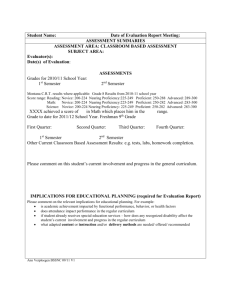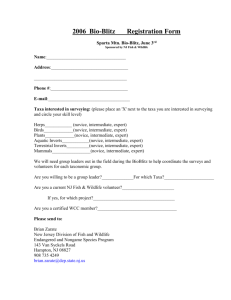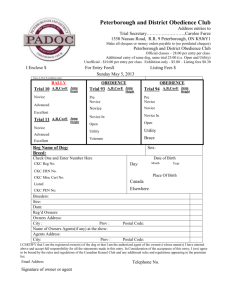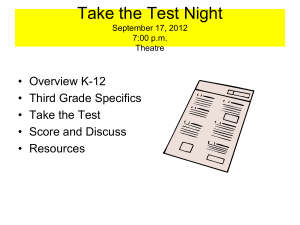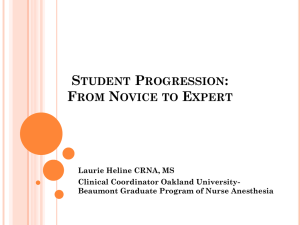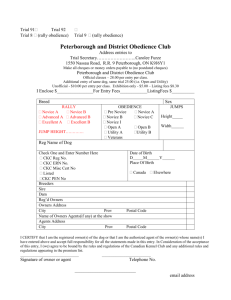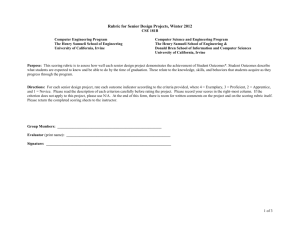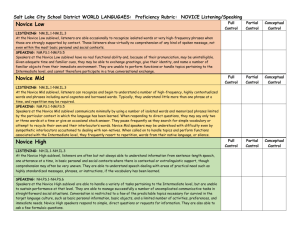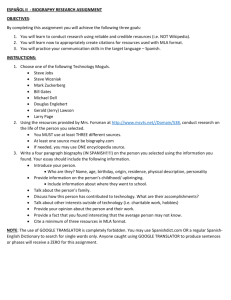Classroom Management - Englishbook In Georgia
advertisement
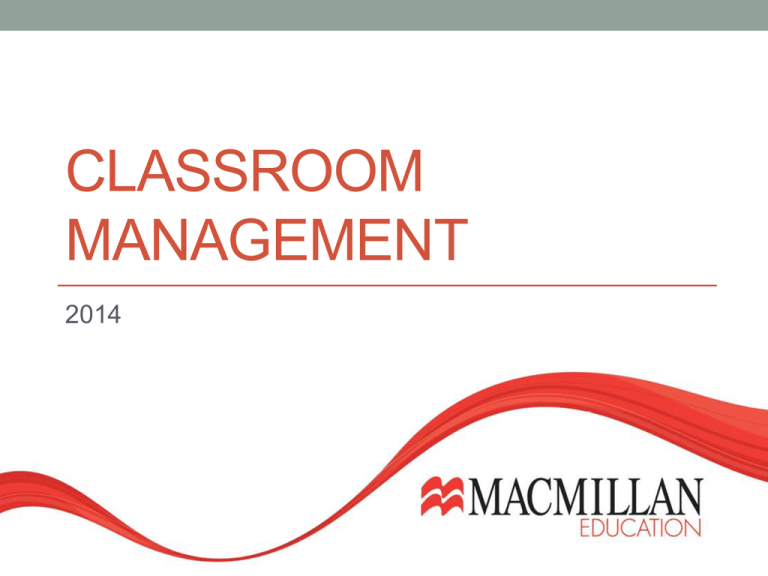
CLASSROOM MANAGEMENT 2014 What might classroom management mean? What would we as teachers like to expect from our students in the classroom? Classroom management can raise a number of concerns…. Worries…? And issues with teaching methodology… We need to consider our objectives and how to achieve them… Rate yourself as a classroom manager! • • • • • • • • • • • • • • • • • • • • • • • • • • • • How would you rate yourself at… 1.1 Organizing classroom space (e.g., seating, resources, technology, decoration) to ensure safety, maximize learning, and meet your overall goals and objectives? Novice (1) Developing (2) Proficient (3) Expert (4) NA • http://usny.nysed.gov/rttt/teachers-leaders/practicerubrics/Docs/SilverStrongSelfAssessmentRubric.pdf 1.2 Keeping the flow of activities in the classroom moving smoothly? Novice (1) Developing (2) Proficient (3) Expert (4) NA 1.3 Establishing a manageable set of classroom rules and procedures and communicating with students about them regularly (e.g., posting them, modeling them, explaining the rationale behind them, discussing their applications in the classroom, and refining them as needed)? Novice (1) Developing (2) Proficient (3) Expert (4) NA 1.4 Providing clear directions for classroom tasks using a variety of modalities (e.g., verbal, visual, physical demonstration) and checking to make sure students understand their roles and responsibilities? Novice (1) Developing (2) Proficient (3) Expert (4) NA 1.5 Developing an effective plan for managing student behavior that includes positive consequences, negative consequences, and an appropriate level of home involvement? Novice (1) Developing (2) Proficient (3) Expert (4) NA 1.6 Managing non-instructional duties (e.g., taking attendance, distributing materials and take-home notices, lunch counts) with minimal disruption to classroom learning? Novice (1) Developing (2) Proficient (3) Expert (4) NA 1.7 Working effectively with other adults in the classroom (e.g., co-teachers, paraprofessionals, aides, student teachers)? Novice (1) Developing (2) Proficient (3) Expert (4) NA What doesn’t work? What happens if you….. • Raise your voice too much • Send the students out of the classroom • Discipline a student in front of the other students • Get really angry A little bit of psychology… • Why do you think children might misbehave? • Attention • Power • Revenge • Display of inadequacy The answers lie with…. • Accepting that some behaviours are age appropriate… • Helping the child to succeed and create activities that he can succeed at • Building self esteem. Often all the child hears are the sentences beginning with “No!” and “Don’t!” so it is very important to make the child feel good about himself • Teaching that “on task” behavior gets immediate positive feedback such as praise In the ESL classroom …what are other issues with managing the students? What’s the solution? • To pre-empt problems (solve issues before they start) by thinking of what to do in advance Where should we begin? What’s the problem? • Power imbalance..the students are in control! • Take control as the person in charge! • Classroom entry…meet and greet. Why? • Make some positive (non-confrontational) statements about what the students are doing right (praise) along with chatting with them • Let’s think of examples of these statements… The students are now calm…what next? Aim? • To get the students seated into the classroom and • • • • • • working as quickly as possible Start by getting attention of the entire group Be clear with your instructions… Which of these is the clearest instruction? 1. “Please be quiet!” 2. “Line up against the wall facing me and no talking please” 3. Line up now please! Keep the noise down!” What else? • Where to start? • Get the students who have done as you have asked to • • • • come to the beginning of the line Give praise to these students (“good job on lining up and not talking!” or “thank you for listening!” ) These students will enter the room first As the students enter what could you say to them?* What action could you take if they are not listening to you? Think for a moment about why this aspect of classroom management may work? Plan…. • Be ready! Have a seating plan on the wall (can be a class plan like this) Alp Felicia Karolin Josef Cem Pedro Ayse Olivia Anton Katia Nil Ahmet Kadir Neco Julietta Ada • Or can be name places (smaller children can write and illustrate their own) • Remember ROUTINES! Be as consistent as you can be EVERY lesson Classroom Layout • How can this affect management? • What can we do to change the layout in a positive way? Where shall I sit? • Look at the cards and decide where you would place these students…. Cards for seating activity B Keeps talking to A P is a fast learner and quick finisher F needs lots of support L argues with whoever is sitting next to her T picks on A A needs some support with writing W fights with P R cannot work alone M has special needs (dyslexia) C has ADHD (attention issues) K is a model student J is a loud and aggressive boy S is quiet and hardworking X is easily influenced by others Y is calm and hardworking D is super chatty What next? • As they sit down, they should have the correct • • • • equipment…text book, note book and something to write with Now they have sat down, they need to be able to start an activity almost immediately Activity can be called a “settling starter activity” (Rob Plevin) Should be something that the children can begin without the teacher’s help Let’s think of examples in pairs… Examples of teacher-free starter board activities •Five anagram words on the board eg; cilpen (pencil etc) •Write the middle or end of 5 known words i.e. enci (pencil) •Write 5 words with a letter missing each. •On a known theme (eg; Classroom objects) write the first letter of 5 different objects to complete. •5 words each with one deliberate mistake in the spelling. •Odd one out i.e pencil eraser cup notebook •They have one minute to write as many clothes as possible, colours, sports,fruit,veg, countries, pets, rooms, hobbies, furniture. •They have one minute to write as many words as they can beginning with…. •Writesixorsevenwordstogetherwithoutabreak Keep Interest • “If students are introduced to topics that interest them, they’re more likely to be motivated!” • But…of couse we are not all interested in the same topic! • However, with each topic we should try to engage as many students as possible. • Old topics need to be “revitalized!” Personalize! Sue, great idea! Well done Joe! Wow, that’s really funny! That’s amazing! Supporting and motivating • What can we do to support the students when the language output is low in relation to the input? Some tips for managing… • PHYSICAL… Move around the classroom • INDIVIDUAL ATTENTION..focus on particular students • SECRET SIGN as a strategy to redirect • USE NON VERBAL CUES Too loud/too much talking • Pair work/groups of three • All participants have a role • Groups can be regularly rearranged as necessary so that students can experience more/less confident peers • Have the students sit close (don’t have to raise their voices) • Give the students a time limit and use a timer to signal that time is nearly up Volume Control ! Shh! Discussing Quiet talking Interesting ideas: http://www.ictgames.com/calmCounter.html or http://toonoisyapp.com/ Activities to reduce noise… • Clapping game • Jar of marbles • Raise your hand! Transition Times… • http://www.teachingideas.co.uk/more/management/files/1 minutedynamite.swf What are your expectations? • If they are too high and your students are struggling what can you do? Differentiated • Definition? • Activity Use positive narration Rules…How?…When?…What? Punishment? Positive reinforcement ATTENTION FOR POSITIVE IGNORE NEGATIVE BE CONSISTENT Typical learner problems in teacher centred classroom She is using too many words! How am I going to learn to say that word myself if only she repeats it and she doesn’t ask me to repeat it? I got lost after the first two sentences…. Why can’t she just explain the directions step by step without saying a whole bunch of other words? Student centred…. • Much better for large classes • If you want to encourage student talk in a crowded class, the • • • • best way to do this is pair/group work The students are close to each other in groups and the teacher can walk around and listen Groups and pairs can be mixed…composed of weak and strong students Pairs can be good for practice/when students need to feel less inhibited and needs to “talk” more But, the larger the group, the less talking time there is for each student… Add student-centered activities • Interact high and low patience activities • Games and competitions to keep students engaged and to encourage participation • Compare and contrast examples of student and teacher centred activities How to keep students engaged? Case Studies…. • Look at the cards that have been given to you • Decide how you could manage the issue in your classroom What do you think that you can take away from this session? Solve the Word Worm! Classroommanagementmay appeartobechallengingbutitcanbeaddresse dby usingthetechniqueswe havediscussedtoday!
